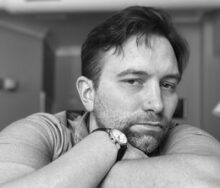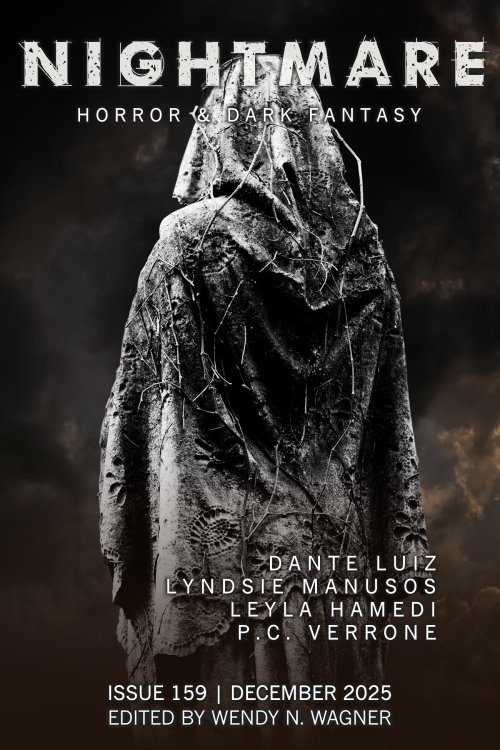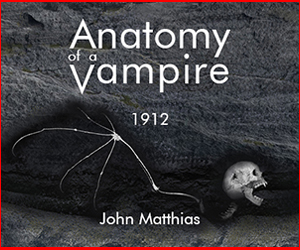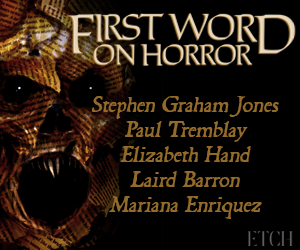Carson Faust is two-spirit and an enrolled member of the Edisto Natchez-Kusso Tribe of South Carolina. He is the recipient of fellowships from the McKnight Foundation, the Camargo Foundation, and the Jerome Foundation. The author of the new novel If the Dead Belong Here, his short fiction has appeared in Never Whistle at Night: An Indigenous Dark Fiction Anthology. He lives in Minnesota.
Let’s start with the basics: Could you give us a little pitch about yourself? What sorts of things do you write?
I’m drawn to stories that invite the dark in to better find the light. A lot of folks would call what I write horror, and I welcome that wholeheartedly. Some of characters that come to me often want things that some might deem impossible: reconnecting with the dead, staving off death altogether, or some kind of power over other people. The worlds they inhabit allow them to go after those things.
My grandma and my aunties have seen ghosts throughout their lives. My late uncle. Or a man on horseback moving through their living room. To me, a ghost is not an impossibility. Ghosts come to us if we let the limits of our feeling fall away. We are still connected to everyone who has ever left us. I am drawn to horror because of the way the genre allows us to maintain those connections and court those impossible feelings. Inviting ghosts to the page allows me to bring my ancestors into the room with me.
I write horror because it is a vehicle for possibility.
When did you start writing fiction? What started all of this, and what keeps you going today?
The first time I remember sitting down at a computer to write something with the intent to keep it and continue it, I must have been nine or ten. My love of words and stories came from my grandma Susie and great-aunt Ann. Some of my very first memories are of sitting on their laps as they read fairy tales aloud to me. I was always interested in the ways that words change when they meet the air.
But many of my first stories were ones I was not ready to speak aloud. They were how I grappled with parts of myself I hoped to hide: my queerness, years of suicidal ideation, feelings of alienation within my own family and the community that surrounded me.
It wasn’t until I entered adulthood that I began weaving family story and inherited history into my work. It’s not lost on me now that my writing pulls from fairy tales and folklore alike, whether that be Brothers Grimm or my own tribal folklore. Throughout childhood, much of my family story went unspoken by my father and our relatives. Through storytelling, I finally felt able to combat that silence. Being able to give shape and life to stories that had been buried or repressed felt necessary to me.
Writing was once a place for me to put shame and keep it hidden. Now it is the place I go to see and feel seen.
What was the inspiration for If the Dead Belong Here? What were some of the obstacles you faced while writing it, and what were the best parts about writing it? What were the books, media, or experiences from real life that inspired this?
This first novel, thematically, is about reconnection. At a story level, it begins with a girl who disappears. My paternal grandma, Betty, in a different way, is a girl who disappeared. Not as literally, of course. Born in Colleton, South Carolina, my grandma was the youngest of her eleven siblings. Both of her parents passed on when she was very young so she was uprooted from her community and forced to relocate to Wisconsin, where their new caretakers were stationed there for military service.
As this story came to me, the most challenging parts and the best parts were one and the same. For the better part of a decade, I sifted through boxes of census records, affidavits, and anthropological studies that centered my family in South Carolina—documents my grandma had brought up from South Carolina long before I was born and had since passed down to my aunties. Sifting through these made me feel close to the family I never knew. It also made me feel even closer to my grandma and aunties as we went through those documents together.
When it came time to give narrative shape to this inherited history, I turned to Helen Oyeyemi’s White Is For Witching. The first draft of this novel, which was initially a short story, pulled from the structure of the first few chapters of that novel. I loved how she brought history to the page through horror and experimentation—how she threaded history through fairy tale and stitched something wholly new. Her writing gave me permission to attempt that with my family’s history.
What was the process like for the structure of the book? You play with time a lot here, and the narrative is constantly jumping back and forth between the past and the present.
Plotting is not in my nature. In the earliest drafts, I was inspired by the structure of Toni Morrison’s Paradise—each chapter centered around a different character. The chapters did alternate geographically—moving between Wisconsin and South Carolina—as they do now, but there was very little temporal structure. As I continued drafting, and with the wisdom of my agent, Annie Hwang, I eventually took inspiration from Mike Flanagan’s retelling of Shirley Jackson’s The Haunting of Hill House. The way his retelling moves so seamlessly through time was a big inspiration point, especially given the intergenerational elements within If the Dead Belong Here. Discovering that temporal rhythm helped the novel take shape and even informed the relationships these characters have with one another.
Since we’re on the topic of histories, you also have a vast web of family histories too. Not only are we looking at Nadine and her immediate family, but also her generational family. How did you develop those relationships? What was it like weaving it all together to make it so cohesive?
The work of a writer, and the work of people, is to recognize patterns and make meaning. Through my research, and looking across the generations of my own family, I was able to reflect on the ways I mirror them. And that is exactly how I approached the echoes in this novel. What does each new generation have the power to change? How much can we change while remaining connected to who we come from? What are we willing to give up in order to persist? What must we hold onto in order to survive? Questions like these kept me grounded as I listened to these characters.
The relationship between Ayita and Barron is tragic and horrifying to watch, but it’s one that certainly happens all too often. What aspects of this relationship did you try to highlight to make the most impact to the story?
The nature of Ayita and Barron’s relationship was one of the most personal to me, which just added to the weight of the responsibility in capturing their dynamic in an authentic way. Those of us who find ourselves in cycles like theirs often soak memory in feeling. We remember things as either monstrous or idyllic. Or we misremember altogether. Imagine inhospitable relationships as fixable. How could we not mend this? Are we not capable of fixing this person? We convince ourselves that this person can fix us.
That hope was the element I tried my best to get right. Both Barron and Ayita had to believe, at some level, that returning to one another was the right thing to do, despite all evidence to the contrary.
I loved all of the aspects and details about Indigenous culture that were present throughout the novel. What did that process look like? Were there things you wanted to add but couldn’t work into the final product?
It might be clear that folklore was my doorway into this story. Without my tribe’s folklore, this story wouldn’t have come to me at all. I wanted to be sure to capture these elements as respectfully and honestly as possible. The ucv’ske, or Little People, are not supernatural to us. They are as real as we are. And I am grateful to have had a team behind me who understood that. There were narrative tools I did not employ—such as narrating entire chapters from the perspectives of the ucv’ske—out of respect for them.
There was nothing I wanted to add that didn’t make the final cut. Rather, I have immense gratitude for the folks who stood behind me as I asserted those boundaries.
This novel has some interesting supernatural and horror elements to it. How as horror influenced you, either as a writer or in your life in general?
Horror began as an act of rebellion for me. It wasn’t until my teenage years that I began sneaking to friends’ places to watch horror movies on their bedroom floors. As mentioned above, much of what first drew me to writing was curating a space for me to place my own fears. Turning to horror allows us to learn how to face them.
You set this in a small town in Wisconsin. What is it about small towns and supernatural forces that mesh so well together?
Small, rural towns in particular have an interesting tension to them: While everyone seems to know each other, there is also often considerable space between people. There are woods, cornfields, long stretches of road, or vacant buildings between folks or families. It is that literal and metaphorical space between knowing and not knowing that allows for folklore, rumor, and complexity to take root. Without the tension between certainty and uncertainty, stories cannot breathe.
If the Dead Belong Here is your debut novel, correct? First off, congratulations! That’s exciting stuff. How are you feeling about all of this?
It is! And thank you. I come at all of this with gratitude. And, honestly, surprise. My quietest goal for the longest time was to get this novel into my grandma’s hands while she is still here. And I’m grateful to say I’ve made good on that. She knows that these stories are hers—and so do I.
I have this running theory that all first novels are origin stories. I am grateful that If the Dead Belong Here and the characters who inhabit it are able to hold so much. I’m glad I was able to follow them through their stories—just as I’m glad they trusted me with them.
What sorts of things are lighting you up right now?
My husband and my friends are my foundation. Their love for and belief in me—long before I had any for myself—is why I am here. I’ve always known I would write, that I would tell stories, but I didn’t always sense that they would be heard. Because my loved ones see me and hear me, I feel capable of sharing the stories I’ve inherited in this new way.
I’m also lifted by the community I’ve found in writing. All of the folks whose words are on the back cover of If the Dead Belong Here are friends and mentors whose work I’ve admired for years. They are also writers who continue their craft through—who understand that building our worlds is the antidote to those who are trying to destroy whatever they get their hands on. I am glad to be in a world with their stories, even if it feels more broken than usual.
What’s next for you? Do you have any projects that you’re working on right now or that you can talk about?
I have been drafting a second novel since before this first one was complete. Thankfully, I’ll get to continue on with my editor, Ibrahim Ahmad, for this new project. He so clearly saw this first novel as I intended it to be seen—so I’m excited to bring these new characters to life.
If the Dead Belong Here is a novel about moving through, surviving, and healing from the past. It is a novel about where we—my tribe—came from. The second novel I’ve been drafting still very much exists within the same world of Native horror, but is more concerned with looking ahead. This work-in-progress asks, instead, where our tribe is going. I am still pulling from folklore that my grandma has passed down—stories revolving around night hags and haints—but I am challenging myself to stay in the present. If I accept this challenge, it will be the ghosts who move through the past. It will be the living who find their way into the future.









